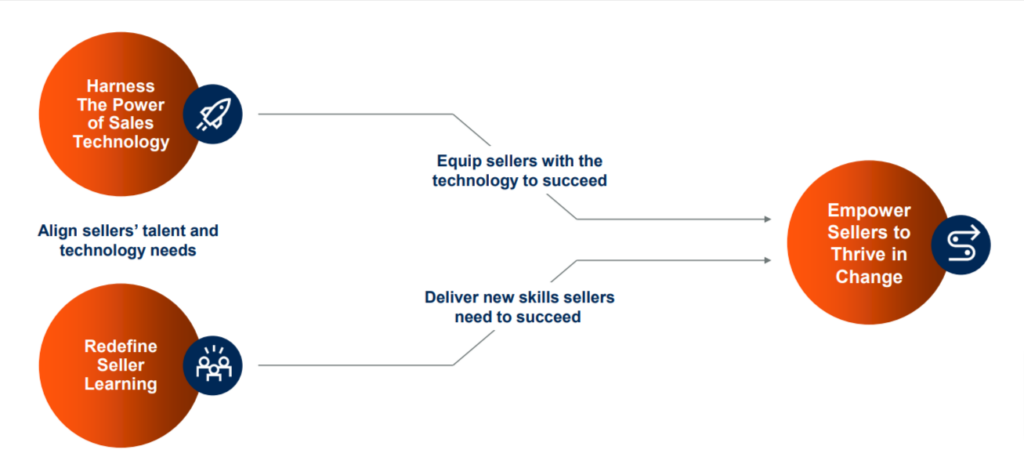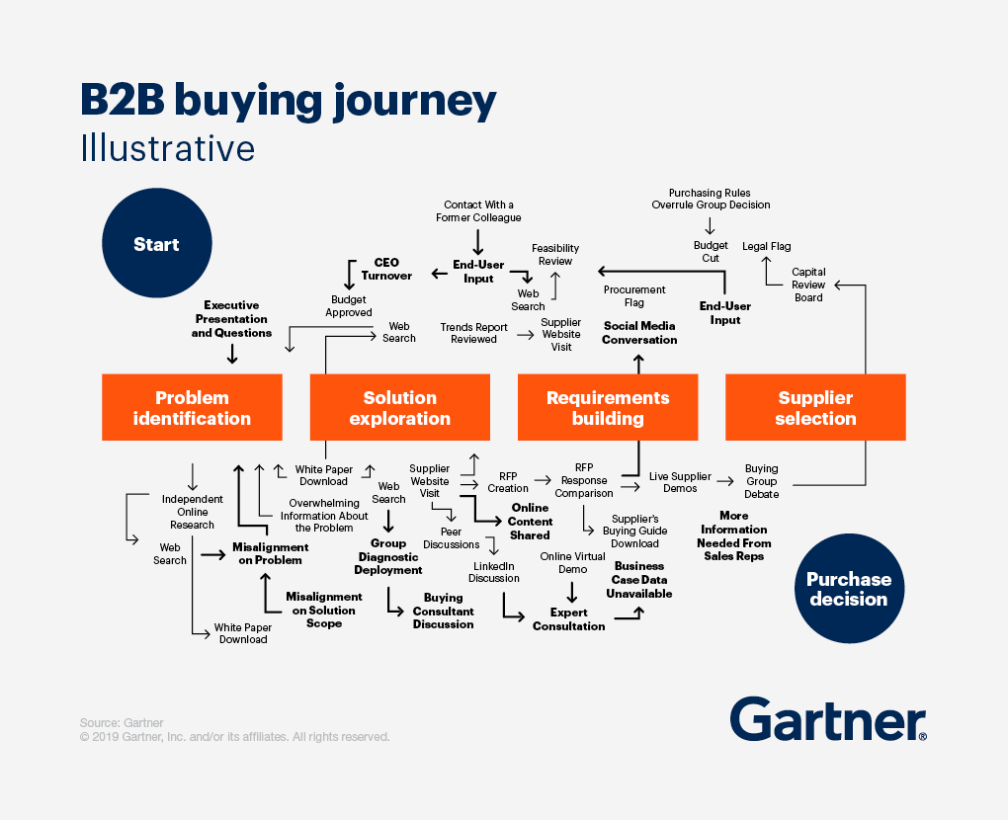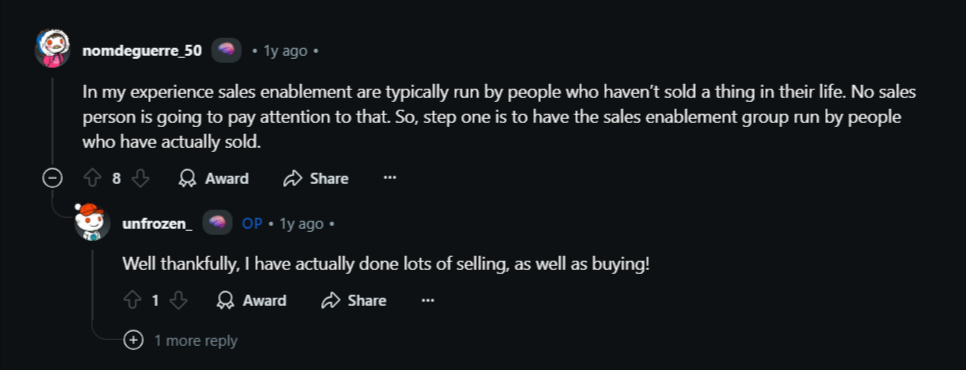Creating a sales enablement program is like trying to juggle while riding a unicycle. Your reps say they don’t have the training or resources to do their job well. Your C-suite is asking you why pipeline and deal velocity rates are down — and you don’t have enough insight into where the real disconnect is coming from.
Case in point: Sales Enablement Collective’s recent report found that 61% of sales reps are struggling to generate pipeline, while enablement leaders say their organization doesn’t place enough value on enablement in the first place.
Now you also have to deal with questions about artificial intelligence (AI). Even though the technology is supposed to transform everything from coaching to content creation, you still have to figure out how to incorporate this into your team’s workflows.
However, it doesn’t have to be a struggle. In this guide, we’ll walk you through exactly how to build a sales enablement training program that includes effective coaching and onboarding — and where AI can realistically fit in so your GTM org does better.
How can you build an effective sales coaching and onboarding program?
A real sales enablement program goes beyond a random “sales training” session or a fancy coach running through an outdated methodology to make sure your reps are always closing. It comes down to the brass tacks — what your reps need and how you can help them get better at their jobs faster and more consistently.
Here’s a six-step process to build that foundation:
1. Understand the current state of your organization
You won’t know how to fix the problem unless you take stock of:
- What your reps know about your product/service
- What resources exist (content/tools/coaches)
- What challenges reps are dealing with
Start by talking to your sales reps and asking them what their biggest challenges are, where they feel stuck, and what resources they use. You can even run surveys or review past performance reviews to find these gaps.
For instance, Stanislav Khilobochenko, VP of customer services at Clario, says the biggest challenges his team faces are:
- Different types of sales reps
- Highly technical cybersecurity products
- Lack of real-time content updates
It’s hard to create a one-size-fits-all program when reps have different levels of technical knowledge and the product team is releasing updates every other week. You need a solution that accounts for these issues because your reps can’t spend hours every week just training themselves.
Next, take a look at your sales data. Look for patterns in win rates, sales cycle length, and common objections. Pay special attention to the gaps between your top performers and everyone else.
What do your best reps do differently? What resources or skills do they have that others don’t? It’ll help you when you’re designing your training program.
Ultimately, you don’t want to create a program where you take experienced reps to kindergarten while new hires are trying to get a PhD in your offer.
2. Define your sales enablement strategy
Once you have a clear idea of the gaps that exist and the challenges to solve, it’s time to map everything. Your sales enablement strategy needs to match your reps’ needs with the larger organization’s goals. So, that’s where you start.
Review your company’s top business priorities in the next year. Expanding into new markets? Increasing market share with existing customers? Launching new products? Your enablement strategy should directly support these goals.
Next, break down the specific skills and knowledge your sales team needs to achieve these objectives. For example, if you’re moving upmarket, your reps might need training on enterprise selling techniques, handling complex negotiations, and building value propositions for C-level executives.
Pro tip: Look at existing sales recordings and use AI enablement tools to identify strengths and weaknesses — and then layer in an AI coaching tool to offer practice through on-demand roleplay scenarios, real-time feedback on sales conversations, and build personalized learning paths based on performance data.

The components of a sales enablement strategy according to Gartner
Tara Furiani, CEO of Not the HR Lady, says that training isn’t a one-and-done thing. Treating it that way leads to measuring the wrong metrics like completion rates instead of the ones that matter, such as deal velocity and close rates. She recommends using the following workflow to build the strategy and refine it:
- Needs analysis (skills gap, tools gap, and stakeholder interviews)
- Training development (content creation, role-plays, and AI-powered scenarios)
- Rollout & feedback loop (pilot programs, real-time feedback, and measurement against KPIs)
Make sure your strategy includes these elements to truly enable your reps.
3. Map your metrics to your enablement strategy’s goals
Here’s where rubber meets road. You can’t measure impact without choosing the right metrics — so it’s time to map each objective with relevant metrics.
Your end goals are a good place to start. If your company’s objective is to increase average deal size by 20%, what enablement metrics would indicate you’re on track? This might include metrics like:
- Percentage of reps selling specific product combinations
- Number of opportunities including premium features
- Volume of deals above a certain contract value threshold
Then, work backward, creating a clear hierarchy of metrics to meet those objectives:
- Business impact metrics: Closed revenue, win rates, sales cycle length
- Behavioral metrics: Improved confidence, use of sales tools, application of training in calls, increased content usage
- Leading indicators: Training completion, knowledge retention scores, better performance feedback
For example, if you want to reduce new hire on-ramp time by 30% in the next two quarters, you’ll need the right resources to make that happen. Take stock of your content resources and feedback on your current onboarding program. Then, create better resources and implement AI-enabled roleplaying or coaching tools employees can use to train on their own time.
Pro tip: Establish a baseline for your chosen metrics before you launch the initiative. You need a way to show the program’s impact and the before-state helps with that.
4. Review the buyer’s journey and orchestrate enablement around it
When you’re enabling your sales reps, you’re essentially teaching them how to cater to buyer needs, irrespective of how “ready” they are to buy. The problem? The buyer’s journey is complicated. We’ve all seen Gartner’s infographic. For the uninitiated, here’s what we’re talking about:
The current state of the B2B buying journey

When the buyer journey is this complex, you realize why reps are finding it hard to meet their KPIs.
To tackle this issue, lay out the entire buyer journey relative to your company’s market and offer.
What questions do prospects ask at each stage? What content do they consume? What objections typically come up? These questions help you understand the real moments that make or break a deal.
Pay special attention to the handoffs between different teams. Where does marketing pass leads to sales? When do sales engineers get involved? These transition points are where deals stall. Your enablement program needs to bridge that gap.
If reps are struggling to articulate a new product’s value, you’ll need more technical training there. But if they’re unable to take a deal over the finish line, that’s a different problem altogether. It could be due to inexperience in a specific market or lack of objection handling and interpersonal skills.
5. Talk to leadership and get buy-in from stakeholders
Buy-in comes at two levels: from leadership and your audience (sales reps and customer success teams). Yet, your audience is often left out of the conversation or taught by someone who doesn’t have the necessary experience.
A quick scan on Reddit reveals comments like this:

A common sentiment among sales reps these days
So, you need to carefully curate the program in such a way that leadership and your intended audience buy in mentally. The best way to get leadership buy-in? Talk from a quantitative perspective.
Connect your enablement plans to metrics they care about — think revenue growth, pipeline acceleration, deal velocity, and customer retention.
You could even show examples of companies that found success with this approach. Companies like Frontier have been able to identify rep readiness and knowledge gaps through Bigtincan’s sales enablement platform. After rolling out a 2-week coaching program, reps scored 93% in the training and 90% in the assessments — indicating the value of a strong enablement strategy supported by a platform that “gets it.”
Give sales and CS reps a glimpse into how you’ll enable them. For example, you might deploy a new sales enablement platform that helps them practice new selling scenarios or create content from an internal repository. Sellers want to sell — so if you can help them get one step closer to getting more time back in the day and doing a better job, you’ll find better success rates.
6. Put your sales enablement training program in motion
Now that you’ve got buy-in for the program, it’s time to implement it. There are three parts of the puzzle you need to figure out:
- People
- Process
- Technology
Ideally, your strategy already accounted for the different experience levels, knowledge gaps, bottlenecks, and available resources. Create a pilot program to test it out with one team. You’ll get feedback before rolling it out — which is critical if you don’t want the program to fail.
Stephanie Cwynar, director of sales enablement at Square, used the 4 Directions of Teaming approach to do this:
- Created the enablement culture first (team within)
- Gained stakeholder buy-in post assessment (team across)
- Defined the ways of working by hiring experienced enablement managers (team through)
- Owned the vision after initial success (team forward)
She started with a team of two that helped her create the enablement assessment and structure and implement the program. But as the metrics improved, she expanded the team slowly to cater to the growing enablement and business needs.
You could take a similar approach. Build the feedback loops and check in with sales reps, managers, and leadership to identify potential problems and nip them in the bud.
For example, are reps happy with the content you’re creating? Can they access the right resources within a shared drive? Are you able to correlate rep performance with training completion? You can use these insights to refine the program before rolling it out.
Pro tip: Use AI tools to objectively evaluate sellers, offer unlimited practice sessions, and automated roleplay scenarios. But you should keep humans in the loop for aspects like emotional intelligence development and managing team dynamics.
How to validate if your sales enablement program works
Here are a few ways to understand if your enablement program actually onboards and coaches reps:
Your chosen metrics show improvement
Ideally, you should see steady improvement in quota attainment across your sales team — not just from your top performers. Look for an uptick in win rates and a reduction in sales cycle length. If that’s the case, your enablement program is working.
That said, you need to look at leading indicators too. For example, review training completion rates, knowledge retention scores, or even frequency of content usage and coaching sessions. If reps are motivated enough to actually use self-serve training materials, you’re on the right track.
Your reps feel more confident in their roles and even ramp up faster
You’ll notice it in the little things first. You’ll see reps asking more strategic questions during team meetings or confidently handling objections they used to struggle with in sales calls.
Even the quality of their interactions increase. They might use specific sales methodologies you’ve trained them on (like MEDPICC) or spin up personalized emails or content without asking marketing or enablement for help.
Similarly, new hires don’t take months to onboard. They can independently conduct calls through on-the-go learning platforms. Or run demos without nudging their managers more often.
A strong enablement program also changes mindset. “We’ve shifted the perception of training from being a ‘box to check’ to a strategic advantage,” explains Furiani. “Reps reported feeling more confident and capable, which translated into stronger performance and better retention rates.”
Your sales reps use your content more often within conversations
Your content will no longer go to waste. Since you’ve put in usage guardrails and a platform to access these resources easily, they can use the collateral whenever they need it.
For instance, many sales enablement platforms track content usage. If reps keep coming back to your repository, you know you’re doing something right. If customers are also engaging with the shared content — that’s when you know your enablement efforts are directly influencing revenue.
You achieve stronger alignment between leadership and GTM teams
You’ll notice that internal teams from product to CS start to articulate company messaging, positioning, and value propositions the same way. Ideally, your entire GTM organization should be using the same language and telling the same story, just from different angles. If you can achieve that through your program, that’s excellent.
In the same vein, you’ll also notice a higher level of cross-functional collaboration between these teams. When you consider that 17% of companies don’t have any cross-functional support for enablement, it comes down to issues like siloed teams, no processes for enablement, and undefined roles for ownership of the program. If your strategy has a clear direction on who should collaborate and how they should do that, you’ll slowly rectify that problem too.
It’s a loop: the more you enable, the better the collaboration. The more the collaboration, the more support you get for your program’s buy-in and growth.
It’s time to create better-prepared GTM teams
If you want to improve your bottom line, your entire organization needs to work better — not just harder. The first step will always be enablement through tools, framework, and technology.
When done right, it helps your reps ramp up faster, close more deals, and deliver better customer experiences. Your content actually gets used (instead of gathering digital dust), and your teams work together more smoothly toward common goals.
This takes a thoughtful and strategic approach. If you’d like to learn more about the technology piece of the equation, here are a few resources to help:
